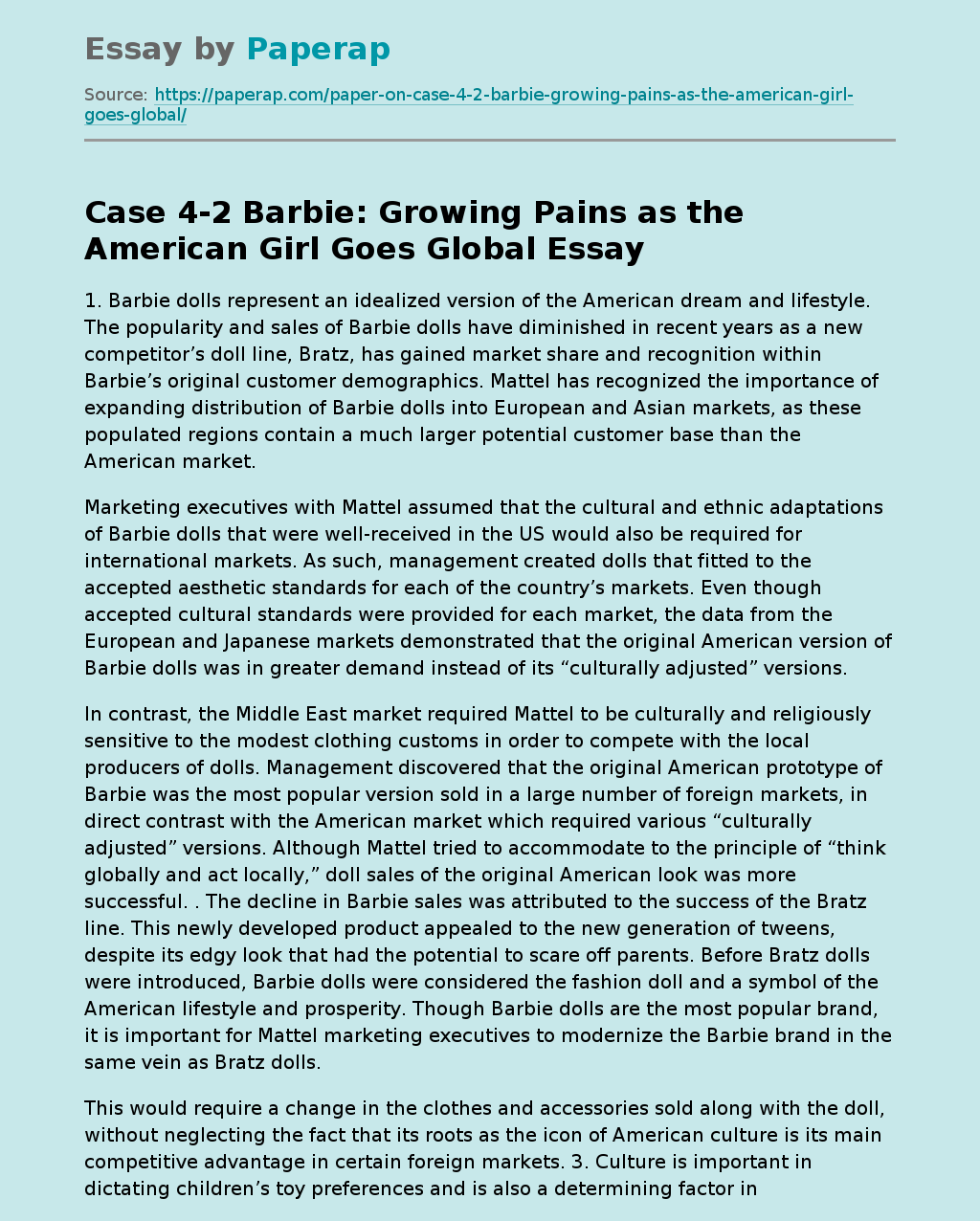Case 4-2 Barbie: Growing Pains as the American Girl Goes Global
1. Barbie dolls represent an idealized version of the American dream and lifestyle. The popularity and sales of Barbie dolls have diminished in recent years as a new competitor’s doll line, Bratz, has gained market share and recognition within Barbie’s original customer demographics. Mattel has recognized the importance of expanding distribution of Barbie dolls into European and Asian markets, as these populated regions contain a much larger potential customer base than the American market.
Marketing executives with Mattel assumed that the cultural and ethnic adaptations of Barbie dolls that were well-received in the US would also be required for international markets.
As such, management created dolls that fitted to the accepted aesthetic standards for each of the country’s markets. Even though accepted cultural standards were provided for each market, the data from the European and Japanese markets demonstrated that the original American version of Barbie dolls was in greater demand instead of its “culturally adjusted” versions.
In contrast, the Middle East market required Mattel to be culturally and religiously sensitive to the modest clothing customs in order to compete with the local producers of dolls.
Management discovered that the original American prototype of Barbie was the most popular version sold in a large number of foreign markets, in direct contrast with the American market which required various “culturally adjusted” versions. Although Mattel tried to accommodate to the principle of “think globally and act locally,” doll sales of the original American look was more successful. . The decline in Barbie sales was attributed to the success of the Bratz line.
This newly developed product appealed to the new generation of tweens, despite its edgy look that had the potential to scare off parents. Before Bratz dolls were introduced, Barbie dolls were considered the fashion doll and a symbol of the American lifestyle and prosperity. Though Barbie dolls are the most popular brand, it is important for Mattel marketing executives to modernize the Barbie brand in the same vein as Bratz dolls.
This would require a change in the clothes and accessories sold along with the doll, without neglecting the fact that its roots as the icon of American culture is its main competitive advantage in certain foreign markets. 3. Culture is important in dictating children’s toy preferences and is also a determining factor in parents’ decisions to purchase a toy that fits into their accepted norms. Sales of Barbie dolls were not adversely impacted in certain markets when Americanized version of the dolls were provided as local culture appeared to play a smaller role in the preferences of doll versions.
The Middle East was the only region in which American versions of Barbie dolls exhibited problems with the accepted cultural standards. Parents in Middle Eastern countries may therefore refuse to purchase toys that are not in line with their values. The competitors of Barbie dolls in the Middle East market, specifically the Fulla doll, are culturally accepted and appear to espouse the same values and beliefs of Middle Eastern parents, therefore these dolls are in greater demand than Barbie dolls. 4. As an “icon” of the American lifestyle, Barbie dolls represent an idealized and aspiration-al adult life for children.
In order to attain this American dream for (a portion of) young girls residing in the US, Mattel has introduced culturally sensitive versions of its dolls. In addition to responding to the needs of its cultural mix, current cultural trends should be incorporated into the dolls. Widely accepted technological innovations, such as smartphones and iPods, could be included as accessories for Barbie dolls to reflect current practices that adults utilize. Thus, these updated dolls would more accurately imitate adult lifestyles. from Keegan and Green, Global Marketing 5th edition
Case 4-2 Barbie: Growing Pains as the American Girl Goes Global. (2018, Jul 19). Retrieved from https://paperap.com/paper-on-case-4-2-barbie-growing-pains-as-the-american-girl-goes-global/

